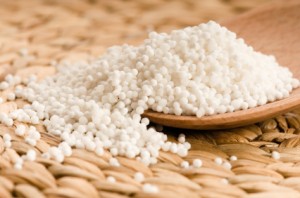Tapioca, most commonly used in pudding, is a starch made from the root of the cassava plant. It can be purchased as granules, flakes and powders, although it’s most commonly available in the form of little round balls. You can make savory and sweet dishes with tapioca, or simply use it as a thickening agent. Naturally low in fat and high in carbohydrates, tapioca can be used in place of arrowroot, cornstarch or flour to thicken sauces and soups.
Benefits
- Carbs and Other Macronutrients:
- A 1/2-cup serving of uncooked tapioca pearls has 272 calories, which is over 10 percent of the daily caloric intake for those on a 2,000-calorie diet. The same size serving also contains minimal amounts of protein and fat, as well as 0.7 grams of dietary fiber. In addition, that 1/2-cup serving has 67.4 grams of carbohydrates. The Institute of Medicine recommends that adults consume at least 130 grams of carbohydrates per day. Pregnant women should get 170 grams of carbs every day, while lactating women should consume 210 grams. Tapioca pearls are rarely eaten plain, so the calorie, fat, protein, sugar and fiber content will change depending on how you use the pearls.
- A Source of Iron:
- Iron helps your body make blood cells, producing the proteins hemoglobin and myoglobin, which carry oxygen in your blood to various parts of your body. Iron also helps produce other proteins in your body. Iron deficiency can lead to weight loss, dizziness, irritability, low energy levels, shortness of breath and headaches. The recommended amount of iron for adult males and women 51 and older is 8 milligrams a day; women 50 and under should get 18 milligrams a day. A 1/2-cup serving of tapioca contains 1.2 milligrams of iron, which supplies between 6.7 and 15 percent of your daily requirement.
- A Gluten-Free Option:
- Gluten-free diets have become more common, even for people who have not been diagnosed with celiac disease, a condition in which your body cannot tolerate even the tiniest amounts of gluten, which is a protein. Those who opt to follow a gluten-free diet by choice often do so because they have a mild intolerance to gluten. Because tapioca is made from cassava, it is naturally gluten free, making it a substitute for flour as a thickener, as well as a base for a tasty, sweet pudding.
- A Low-Sodium Choice:
- Tapioca is naturally low in sodium, containing only 2 milligrams per 1-cup serving. According to Colorado State University Extension, the majority of Americans consume too much sodium every day, increasing their risk for cardiovascular disease. The daily upper limit for sodium is 2,300 milligrams for adults. The limit drops to 1,500 milligrams if you are over 51, you are African American, or you have a history of heart disease. Just remember that tapioca is usually just one ingredient in a dish, so watch your added salt to keep the dish low in sodium.
References
Source: www.livestrong.com/article/509033-the-health-benefits-of-tapioca/

